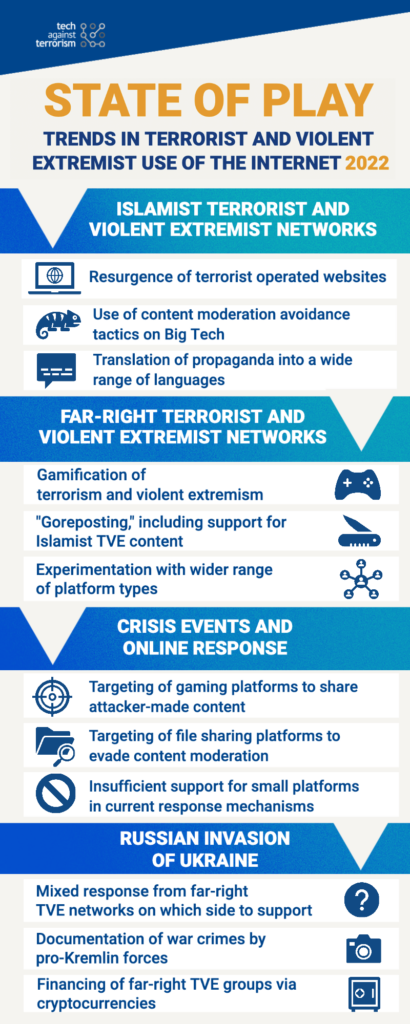2 min read
State of Play: Trends in Terrorist and Violent Extremist Use of the Internet 2022
Saqeb Mueen Jan 19, 2023 9:24:48 PM
In its annual review of terrorist and violent extremist activity online, Tech Against Terrorism examines how terrorist and violent extremist entities have expanded their online capabilities over 2022.
20 January 2023
The report charts the principal shifts in terrorist and violent extremist (TVE) behaviour and tactics online, and aims to inform more comprehensive cross-industry efforts to counter TVE exploitation of the internet.
The report also highlights the urgent threat posed by terrorist-operated websites which undermine the global efforts to disrupt online terrorist activity taken elsewhere across the tech ecosystem.
The report examines four areas:
- Islamist terrorist and violent extremist use of the internet
- Far-right terrorist and violent extremist use of the internet
- Crisis events and online response
- Global events, namely the Russian invasion of Ukraine
KEY FINDINGS
- TVE entities have expanded their online capabilities through the exploitation of new platforms and platform types to share propaganda, communicate, and fundraise.
- Most trends in TVE behaviour outlined in this report are caused at least in part by the improved content moderation undertaken by tech platforms in recent years. The trends demonstrate the continued resilience and adaptability of TVE networks online.
- Terrorist- and violent extremist-operated websites are an increasing threat in the online landscape due to the ease of creating such websites and the difficulty of removing them.
- Islamist terrorists and violent extremist entities, including Islamic State, have adapted their online presence to evade content moderation by hosting their own platforms and servers, as well as building their own websites and file-hosting platforms. Moving to these spaces makes the task of disrupting their content online an increasingly difficult one.
- Far-right terrorist and violent extremist networks have experimented with new platforms and platform types - in particular, for sharing attacker-produced content. We have also identified these networks increasingly posting graphic and violent content, regardless of ideology, such as official Islamic State content.
- Following attacks in Buffalo, New York (May), Udaipur, India (June), and Bratislava, Slovakia (October), we monitored the spread of attacker-produced content across the tech ecosystem. We assess that small platforms are increasingly targeted as a means of sharing this content but are often not included in current crisis response mechanisms, allowing the content to remain online for longer.
- The Russian invasion of Ukraine galvanised support for far-right violent extremist pro-Kremlin networks which will almost certainly grow as the war goes on. Coordinated disruption of these networks will be better enabled by terrorist designations and further sanctions.
Moving into 2023, Tech Against Terrorism will continue to support the tech sector in tackling and disrupting TVE exploitation of the internet through tracking, analysing, and alerting the presence of TVE entities across the entire online ecosystem. We will particularly be focusing on expanding our support for infrastructure providers, increasing our crisis response abilities, and providing comprehensive support to tech companies of all sizes.

- News (240)
- Counterterrorism (54)
- Analysis (52)
- Terrorism (39)
- Online Regulation (38)
- Violent Extremist (36)
- Regulation (33)
- Tech Responses (33)
- Europe (31)
- Government Regulation (27)
- Academia (25)
- GIFCT (22)
- UK (22)
- Press Release (21)
- Reports (21)
- US (20)
- USA (19)
- Guides (17)
- Law (16)
- UN (15)
- Asia (11)
- ISIS (11)
- Workshop (11)
- Presentation (10)
- MENA (9)
- Fintech (6)
- Threat Intelligence (5)
- Webinar (5)
- Propaganda (3)
- Region (3)
- Submissions (3)
- Generative AI (1)
- Op-ed (1)